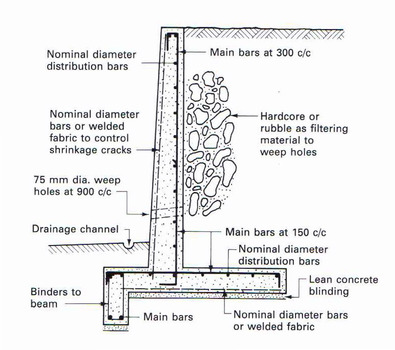Coordinating Responsibilities in SRW Projects
On all projects involving soil retaining walls (SRWs), It is crucial to communicate the engineering design effectively within the scope of work, including structural design, civil design, and geotechnical design. Throughout the project, the owner’s representative must establish clear and distinct professional roles and responsibilities to prevent confusion regarding who is responsible for investigating, analyzing, and designing the SRWs. Typically, the contractor must be responsible for coordination during construction. The design professionals provide all necessary and required project information, engineering analysis, and inspection. The owner often relies on a design professional, such as a civil engineer or architect, to represent them. However, it is also possible for the contractor and engineers involved in the project to represent the owner and offer coordination. Whether it is an architect or contractor acting as the owner’s representative, they must ensure that all necessary engineering work is carried out.
Tailoring Retaining Wall Types to Site Constraints
Before designing and constructing retaining walls, choosing a suitable wall type based on the site’s conditions and limitations is essential, ensuring the wall alignment fits within the site’s unique constraints. Constraints may include existing structures such as buildings, roads, sidewalks, utilities, and landscaping. If there is an existing structure that may compromise the SRWs. In that case, it may be beneficial for the structural engineer to have a conversation with the civil engineer and contractor to discuss changing the wall to a near-vertical system. A near-vertical system can resolve some issues regarding layback and block offset. A near-vertical wall may give more space between an existing structure and the wall location, which may impact the reinforcement grid length used in the structural design. A double-block gravity system is an alternate method that may allow room for existing structures instead of grid reinforcements.
The Crucial Role of Communication in SRW Design
Effective communication is crucial for coordinating the design process of an SRW. The contractor, civil engineer, geotechnical engineer, and structural engineer all have essential roles in the project. The civil engineer is responsible for specifying the location of retaining walls, preparing a site plan, grading plan, and grade slopes. They also design surface grading for drainage and erosion control, stormwater collection structures, detention/retention ponds, and tie the drainage system into the storm drainage system. During civil engineering design, it is crucial to take into account the distance between the SRWs and property lines. Placing a retaining wall too close to the property line can lead to issues during the structural engineering phase, especially regarding grid reinforcement.
To ensure the stability of an SRW, the structural engineer needs to work closely with the geotechnical engineer. The geotechnical engineer and a testing agency provide all the necessary information about the soil, including soil exploration, analysis, and earthwork inspection. The structural engineer must also consider factors such as reinforced soil fill, bearing pressure, soil unit weight, cohesion, groundwater conditions, and the properties and strength of the retained soil and rock. By gathering this information, the structural engineer can design the SRW for structural stability, sliding, overturning, and internal stability and determine the maximum unreinforced height. Throughout the project, the engineers need to communicate effectively to ensure an efficient timeline for the project involving SRWs.
In Summary
Effective communication among stakeholders, including contractors, civil engineers, geotechnical engineers, and structural engineers, plays a crucial role in achieving a successful SRW project. It is essential to select a suitable wall type that is compatible with each site’s unique constraints. And maintaining continuous coordination between the contractor, structural and civil engineers throughout the construction process will help resolve conflicts early, ensuring that the wall design is implemented successfully.











